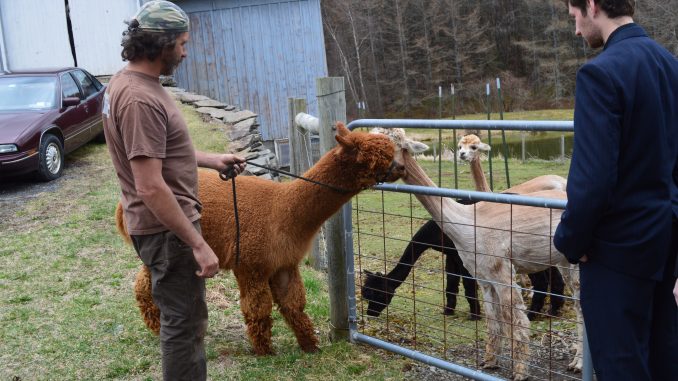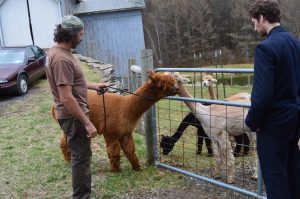
Alex Fredkin- Managing Editor

Just outside Oneonta there is a small quiet town called South Kortright. This area does not seem like anything out of the ordinary at first, but down a long unassuming road sits something many would not expect to find in Upstate New York—an Alpaca Farm.
Gunhouse Hill Alpacas is a family-run farm that specializes in Huacaya Alpacas, which originate in the Andes mountain range of South America, between Peru, Bolivia, and Chile. Matt and Diane Taylor own the farm, which has over 30 alpacas. They are used for breeding purposes as well as producing high-quality clothing. Some of their animals have even won competitions based on their wool, physical qualities and behavior.
There are two types of alpacas, Huacaya and Suri. Fleece from a Huacaya is wavy and has a crimp to it, so it fluffs up. Suri alpacas don’t have the crimp, so their fiber hangs down to the ground.
The State Times was lucky enough to visit the farm on shearing day, which happens only once a year. A sheared alpaca will produce around 5-10 pounds of fleece each, for their coat can get as long as a couple inches. With 30 alpacas, the Taylors and their crew had a lot of work to do.
Alpacas appear larger than they actually are due to the fleece; the animals stand about 36 inches tall, and the biggest ones only get to around 200 pounds. Their fleece comes in 22 natural colors, anything from solid white to black, and any shade of grey and brown in between. Sometimes it is patterned as well.
An alpacas’ life-span is around around 20 years. The younger the alpaca the nicer and softer the fleece. As they grow it gets shorter, more coarse, and turns grey. Gunhouse Hill Farm sends their fleece to a co-op in Massachusetts where it gets combined with fleece from other farms. It is hypoallergenic, three times warmer than wool, and can be turned into anything from jackets, mittens, hats, boot inserts and even “organic stress balls.” Clothing made from this fleece can be compared to cashmere in quality, but is actually more durable and easier to care for.
After watching the shearing for some time we were allowed to go inside the pen and get up close and personal with the animals. The Taylors were very gracious and allowed us all the time in the world to meet their animals. Three females immediately came over to check us out and see what was going on.
Alpacas usually do not spit—contrary to popular belief—their larger cousins, llamas, do this more often. Alpacas only have bottom teeth and don’t bite either. Only two types of camels, llamas and alpacas make up the camelid family.
Once they got comfortable, the animals came right up to us, smelling us and letting us pet them; one even sat down right next to us. They are very inquisitive and curious animals, but also have very different personalities. While some enjoyed the attention, others stayed way back in the fenced off area and never came near.
The Taylors have been farming alpacas for around nine years, and have grown their farm from seven originals to their total today of over 30. The State Times had a lot of fun learning about Alpacas. Gunhouse Hill has a shop where they sell alpaca-wool clothing items, so even those that are not interested in purchasing an animal can go and get a nice warm pair of socks or a hat. They have a website at gunhousehillalpacas.com, if you are interested in learning more.
Leave a Reply